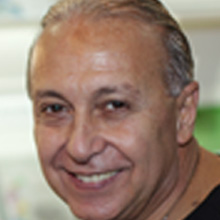Me complace mucho, de verdad, tener este vis a vis con un artista excepcional. Me refiero al caricaturista e ilustrador argentino Luis Ordóñez.
Él trabaja ininterrumpidamente en las más reconocidas revistas nacionales y extranjerase. Sus escuelas de dibujo humorístico y caricatura son las más concurridas de toda Latinoamérica.
Fue el primer caricaturista contratado en televisión en su Argentina. Ha expuesto sus obras en distintos países como Canadá, Bélgica, Japón, Alemania, Estados Unidos, Francia, entre otros.
En el año 2012 fue reconocido internacionalmente por su gran talento y creatividad y distinguido por el Gobierno de Francia, en la ciudad de Saint Just Le Martel, entre más de 1500 caricaturistas de todos los continentes, como el mejor caricaturista del mundo.
Tengo razón para estar honrado de conversar con él, ¿no es cierto?
PP: Maestro, no sé si lo hice bien, si me faltó algo. ¿Podría presentarse usted mismo para los seguidores de Humor Sapiens?
ORDÓÑEZ: Bueno, soy Luis Ordóñez y desde hace aproximadamente 47 años que no trabajo. ¡Qué raro suena eso! En realidad, cuando uno tiene la dicha de poder hacer lo que le gusta, cuando Dios te bendice de esa forma, deja de ser trabajo. Como dije, hace 47 años que trabajo ininterrumpidamente como dibujante y como caricaturista.
PP: ¿Cómo llega a la caricatura? ¿Algún dibujante le influyó, tuvo un guía en esos inicios? ¿Alguien de su familia o cercanos a usted eran artistas?
ORDÓÑEZ: Mis comienzos se fueron comprobando como habitualmente pasa: en las escuelas primarias. En principio a mí me sucedió, de que llamaban a mi mamá para decirle “Por favor, no les haga los dibujos al nene” y pobrecita mi viejita no sabía dibujar nada. Los hacía yo. Creo que Dios nos da un talento a veces a cada uno y tengo un talento innato que después fui perfeccionando por supuesto. Pero ya desde chico me gustaba, curiosamente, no solo dibujar sino la caricatura. Realmente le debo esta influencia a uno de los mejores caricaturistas que conocí, que lograba el cometido de todo caricaturista: que la gente reconozca quién es el caricaturizado, aunque no esté el nombre y fundamentalmente que la gente conozca quién es el artista, quién lo dibujó, aunque no esté la firma. Eso se llama estilo. Y yo veía las caricaturas de Abel Ianiro que salían en la recordada y vieja revista Canal TV de Argentina, donde salían caricaturas increíbles. Y yo decía cómo se puede deformar alguien y conseguir semejante parecido. Distorsionar la realidad. Así que él fue quién me incentivó, quién influyó. Yo quería hacer, yo quería aprender hacer eso. Pero, desgraciadamente, no había escuela que me enseñara a dibujar eso. Solo me ponían el clásico jarrón, la manzana, me decían que lo dibujara y yo me aburría. Entonces iba un mes, o dos meses, a distintas escuelas que me mandaban, pero no conseguía una que me enseñara lo que me prometían: dibujar caricatura. Así que, siguiendo los pasos de los que me antecedieron uno empieza a copiar primero (es lo que habitualmente sucede con la mayoría), hasta que después uno tiene ya las ganas de crear su propio trabajo, su propia caricatura. Ahí es donde nace ese desafío, donde comencé a dibujar a la familia, a los profesores, a mis amigos… ahí empecé a perder amigos, je je, porque no todos les gusta las caricaturas… No, mentira, no los perdía, pero sí eran los que me ponían a prueba y por supuesto, los que me daban la posibilidad de practicar, porque cara a cara es un desafío. En fin, esos fueron mis comienzos. Y el que me incentivó, como ya dije, fue Abel Ianiro, un grande la caricatura argentina.
PP: Sin dudas, desde bien temprana edad ya se sabía que iba a ser un grande en su especialidad. Dígame algo, ¿ha evolucionado su obra desde que comenzó hasta hoy? Y no me refiero al producto de la práctica, de la experiencia. Pienso en si ha cambiado su forma de hacerlas, su estilo.
ORDÓÑEZ: Por supuesto, uno va cambiando con los años, con el tiempo. Para muestra vale un botón, dicen. Uno ve el Mickey que conocimos todos, ese ratoncito negrito, hermoso, cómo fue mutando, cómo fue teniendo esa transición. Obviamente que el avance no fue solo tecnológico, sino el mismo dibujante va cambiando por inercia -a veces sin darse cuenta-, la forma, las características, más que el estilo de la modificación del dibujo. Pero yo tuve entre muchos defectos, algunas virtudes y la virtud que más resalto es que no me gustó quedarme en el tiempo; es decir, me adapté a todas las tecnologías. Empecé a practicar no solo lo que uno conoce tradicionalmente, sino con la tecnología digital con programas de computación que te permiten pintar de otra forma, hacer y lograr efectos que a veces es difícil de obtener con el pincel. Por supuesto, que uno va cambiando técnicas, pero el estilo queda. Es decir, la gente reconoce quien hizo el dibujo y eso es lo más importante.
PP: Pues seguro que el público le agradece que se haya adaptado a los tiempos. Ahora, algo más específico: ¿cómo escoge a sus modelos a caricaturizar? ¿Lo ve y enseguida le viene a la mente la caricatura o solo lo ve y sabe que es un potencial modelo y después lo trabaja y va saliendo, haciendo camino al andar?
ORDÓÑEZ: Fueron muy pocas las veces en 47 años de profesional en que tuve la posibilidad de elegir. Siempre tuve la dicha de trabajar en los mejores programas de televisión de mayor rating, como los programas de Sofovich, “Grandes valores del tango”, “Todos los goles”, “El Show de Carlitos Balá”. Y tuve la oportunidad de trabajar, además, en las mejores revistas del país, desde “Radiolandia 2000”, “El Gráfico”, “Antena”, y en todos los diarios de Argentina. Entonces, no tenía posibilidades de elegir el modelo, sino que me decían: “hay que dibujar a tal o cual persona” y me tenía que adaptar. Lo que sí a veces hay que tomarse el desafío de que te dicen: “Hay que hacer la caricatura de fulano, pero riéndose” y por ahí es una persona que está siempre seria, por lo que tenía que tener la responsabilidad no solo de lograr el parecido, sino de cambiar la expresión y, obviamente, de mantener el parecido. Pero, repito, no tuve muchas posibilidades de elegir. Eso sí, siempre tuve la dicha de Dios de trabajar muchísimo y eso me obligaba a adaptarme a lo que me pidieran. Lo que sí uno logra y consigue también es que, cuando veo a la persona, ya sé cómo caricaturizarla. Es decir, el secreto de la caricatura es primero lograr ver la deformación en la mente. Yo veo a la persona y ya distorsiono y ya sé qué es lo que tengo que plasmar en el papel. La diferencia entre el retratista -que, obviamente, tiene un mérito increíble-, que se limita a copiar lo que ve, es que el caricaturista tiene que plasmar en el papel lo que se imagina, lo que distorsiona. Así que uno aprende con el tiempo, con la trayectoria de los años, con la experiencia, a que cuando ve a la persona ya sabe qué resaltarle, qué exagerar. De esa forma, no solamente conseguir el parecido, sino sacar -si es posible-, el alma del personaje para cuando la gente vea el dibujo.
PP: Increíble imaginarse ese proceso. ¿Y cuál es el método para captar el alma del modelo, su personalidad, y plasmarla en su dibujo?
ORDÓÑEZ: Uno tiene que conseguir eso: tratar de volcar el alma del personaje en el papel y muchas veces no son rasgos físicos solamente, sino también volcar las características, los gestos, las expresiones. Tratar de que sea reconocido a primer golpe de vista la persona, aunque uno le tape la mitad de la cara. Saber de quién se trata. Por ese motivo es que uno busca, obviamente, no solo el parecido sino -perfecta la pregunta-, la personalidad para que la gente puede identificarlo y reconocerlo fácilmente.
PP: ¿Cuál sería su definición de caricatura?
ORDÓÑEZ: Para mí, la definición de caricatura es volcar el ángel humorístico que cada uno tenemos. Es decir, la caricatura, a lo contrario de lo que dice la Real Academia Española, que es: “La ridiculización de la persona o de la cosa”. Yo nunca estuve de acuerdo con esa forma de expresarla, de definirla. Para mí es resaltar o agasajar a la persona por medio de la caricatura. De que sea algo diferente a un retrato. Por ese motivo tuve muchos años haciendo caricaturas en vivo, en televisión, donde el invitado iba inclusive hasta enemistado con los periodistas o conductores. Los he escuchado decir en cámara -que me daba vergüenza, porque lo decían delante de mí-, que iban al programa solo para llevarse el recuerdo de la caricatura. Entonces para mí eso es un halago tremendo, ya que le daban un valor que iba más allá de un simple dibujo. Porque valoran que uno lo hace con esa pasión, con la sincronización del pulso, de la imaginación y de algo que está a solo a 40 centímetros del cerebro que nos permite imaginar: el corazón. Cuando uno vuelca esa pasión, la gente se da cuenta y se transforma en algo más que un dibujo, repito, en algo más que una caricatura. Esa es la definición que yo tengo de este arte tan lindo que es la caricatura.
PP: Bueno, yo tampoco coincido con la RAE. Sin embargo, creo que la caricatura personal es una forma de parodia. Y sí se hace para lograr sonrisa o risa. El meollo del asunto es que para que sea real su definición, la víctima debe sonreír a la par que el caricaturista y los espectadores. De ahí que los invitados a su programa la valoraban. Sabemos que usted logra eso, pero hay otros colegas que trabajan la caricatura personal para satirizar. Y tienen derecho a hacerlo también, por supuesto. Supongo que eso es lo que provoca la confusión de la RAE. Pero hay otra arista en este punto. Conozco gente convencida que la caricatura y la caricatura personal no pertenecen al humor gráfico. ¿Qué piensa usted?
ORDÓÑEZ: Por supuesto que la caricatura pertenece, sin lugar a dudas, no solo al humor gráfico sino a las artes plásticas. Siempre el caricaturista estuvo catalogado como que hace un arte menor. Siempre se dijo que la caricatura era la hermana boba de las artes plásticas. En realidad yo -obviamente defendiendo lo mío-, considero que tiene muchísimo valor. Y la prueba está en que el Museo del Louvre me dio la posibilidad de que exponga. Vuelvo a repetir: un caricaturista y dibujante contemporáneo, exponiendo en uno de los Museos más emblemáticos del mundo. Así que, para mí, pertenece a las artes plásticas y al humor gráfico.
PP: De acuerdo total. Si al hacerla caricatura personal hay una intención de hacer reír o sonreír (como la tiene sin dudas), pertenece al humor gráfico. Y a las artes visuales, más que claro está. Y de que no es un arte menor, es indudable. Hay que estar muy confundido o tener muy mala sangre para denostar este arte. Pero cambiemos un poco. Maestro, ¿le ha sucedido que de pronto le aburre hacer siempre caricatura personal y le dan ganas de abordar otras modalidades? ¿Le gustaría hacer algo dentro del humor que nunca haya hecho?
ORDÓÑEZ: En 47 años hice todo lo relacionado al humor. Hice humor político, social. Por ejemplo, en el Miami Herald, donde era más difícil porque uno tiene que conocer la idiosincrasia y las características y la vida cotidiana -políticamente hablando-, de un país que no es el tuyo. He hecho dibujos animados; he hecho publicidad humorística, he hecho historietas. Hice de todo dentro del dibujo e incursioné en el humor escénico, actoral, contando chistes, haciendo humor. Por ejemplo, en “Finalísima del humor”, donde tuve la suerte de ser jurado durante los 3 años que duró el ciclo y dentro de los 5 jurados permanentes del programa haciendo humor. Lo mismo en los programas de Quique Dapiaggi como “La chispa de mi gente” y “De mi pago con humor”, donde en un programa Federal que había un representante de cada provincia, yo representaba, obviamente, a mi ciudad: Buenos Aires. Y hacía humor no solo dibujado, escrito, sino también oral. Así que tuve la dicha de incursionar en todo lo relacionado con el humor. Es una bendición, como dije al principio, hacer y vivir de lo que a uno le gusta.
PP: Pues mis felicitaciones, porque es usted un “todoterreno” en el humor. Ese es otro don que tiene. Y voy para otra habilidad divina: fundó una Escuela de Dibujo que tiene gran prestigio tanto en Argentina como en otros países. ¿Cómo le ha ido con ese gran proyecto?
ORDÓÑEZ: Tuve la dicha de que un día me decidí a poner una Escuela de Dibujo. Me costó tomar esta determinación 10 años de profesional. Pero claro, trabajando en programas tan populares, la gente escribía más de 200 cartas en el mes, preguntando dónde enseñaba. Y yo realmente no enseñaba en ningún lado. Primero, porque decía “cómo alguien puede aprender con un profe que no aprendió, por lo menos en forma ortodoxa”. Es decir, soy autodidacta. Y cuando uno dice autodidacta, también se refiere a que fue copiando a los que los que antecedieron a uno. Pero aprendí solo, sin que nadie me dijese cómo se prepara determinado color, cómo se agarra el lápiz, qué lápiz hay que usar y demás. Entonces me costó decidirme y cuando lo hice, la sorpresa fue que en una semana se anotaron 300 personas. Entonces, ahí me di cuenta del poder de convocatoria que uno tenía, la promoción que la televisión me había dado. Y ahí empezó, como dije al principio hace 37 años. Ya antes de la pandemia teníamos 3 Escuelas en Buenos Aires: una frente a Obelisco, otra en Caballito, otra en Villa del Parque, otra en Lanús. Perdón, 6 en total en Argentina. Una Cipolletti en Río Negro y una en Rosario. Además, la primera Escuela Internacional, la cual se abrió en Miami, en Coral Gables, donde también tuve la dicha de tener una Escuela muy concurrida en todas las sucursales. Fue algo maravilloso, una experiencia increíble, donde la pandemia me hizo tomar una decisión. Bueno, la pandemia y mi hija, que me dice: “¿por qué no damos los cursos por Zoom?”. Y yo no sabía qué era Zoom, pero gracias a Ileana y a mi hijo Lukas, que es otro gran profesional del dibujo, empezamos a dar los cursos online. Bueno, lo hacemos actualmente. Y hoy tenemos una Escuela al Mundo, porque tenemos alumnos de distintas partes del Planeta. Hasta de Turquía (que habla español por supuesto). Así que esto hizo que se abriera una Escuela al Mundo. En realidad, fue maravilloso. Tenemos una cantidad increíble de alumnos. Entonces se hace difícil que vuelva a los cursos personalizados. Es que esto lo hemos hecho muy bien. Por ejemplo, con mi esposa en la pandemia, creamos un estudio de grabación en casa, donde se han grabado las lecciones con mucha minuciosidad, con muchos detalles, para que el alumno pueda ver bien detenidamente en qué forma se pinta, con qué forma se trabaja o de qué forma se trabaja. Así que esto vino para quedarse y así lo seguiremos haciendo.
PP: Fantástico. De nuevo mis felicitaciones. Ahora, ¿hay alguna pregunta que no le hice y le hubiera gustado que le hiciera? Si es así, ¿puede responderla ahora?
ORDÓÑEZ: La pregunta que respondería, aunque no se me hizo, es que todo esto no es mío. Es un don que Dios me regaló, sin lugar a dudas, porque alguien que no aprendió ortodoxamente que pudo haber logrado tanta trayectoria, tantos premios, tanta cantidad de miles y miles de alumnos, viene de algún lado. Y para mí siempre viene de Dios. Creo que hasta él mueve el lápiz por mí. Soy un bendecido, sin dudas, por hacer este trabajo. No me canso nunca, me encanta dibujar a pesar de la cantidad de años que uno lo hace. Cada día siento más pasión. Así que la respuesta a esa pregunta es esa, simplemente es un don que Dios me dio.
Muchas gracias por la entrevista. Un gran saludo para todos.
PP: Estimado, de verdad que ha sido un placer este intercambio. Le agradezco infinitamente que haya aceptado participar en este vis a vis. Le deseo mucha salud y que sigan los éxitos.
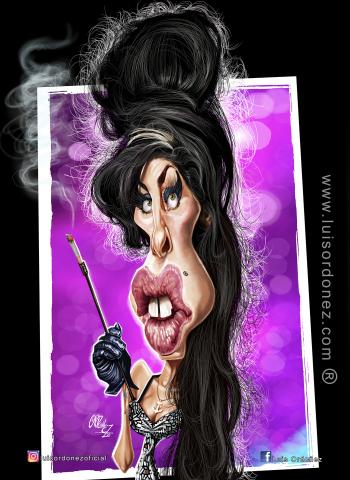
Amy Winehouse... Luis Ordóñez
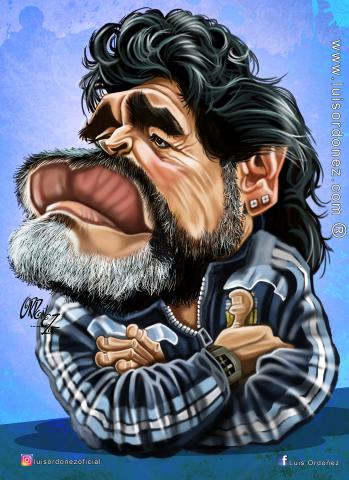
Diego Maradona...Luis Ordóñez
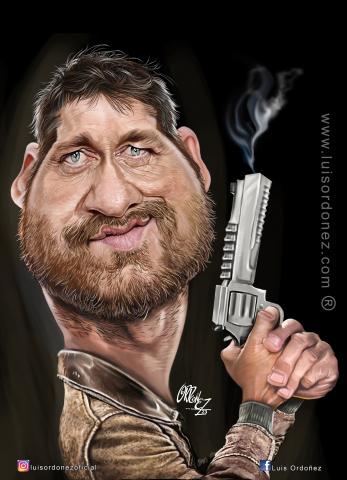
Gerard Butler... Luis Ordóñez
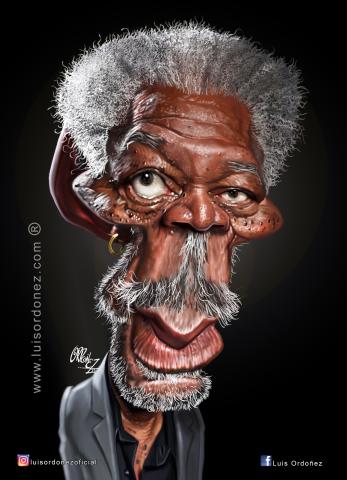
Morgan Fredman... Luis Ordóñez
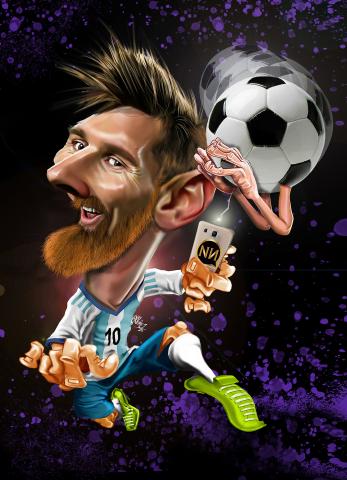
Lionel Messi... Luis Ordóñez
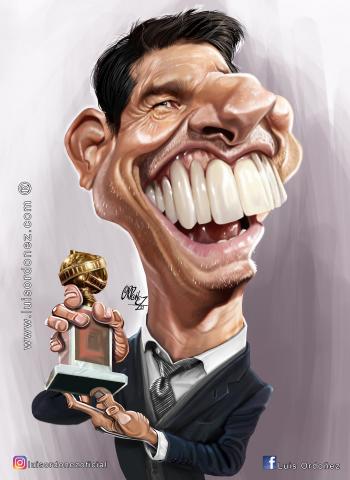
Tom Cruise... Luis Ordóñez
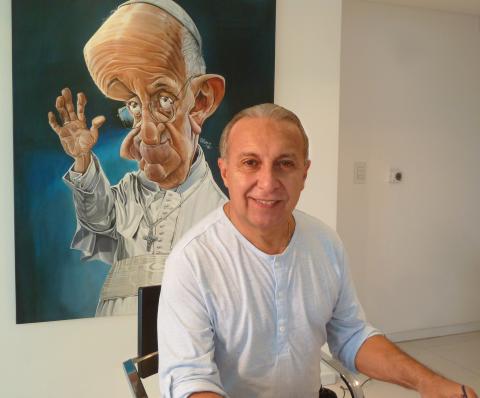
Luis Ordóñez
Interview with Luis Ordóñez
By Pepe Pelayo
It is a blessing to do and live what you like.
I am very pleased, truly, to now “talk” with an exceptional artist. I am referring to the Argentine caricaturist and illustrator Luis Ordóñez.
He works uninterruptedly in the most recognized national and international magazines. Its humorous drawing and caricature schools are the most popular in all of Latin America.
He was the first cartoonist hired on television in his country. He has exhibited his works in different countries such as Canada, Belgium, Japan, Germany, the United States, France, among others.
In 2012 he was internationally recognized for his great talent and creativity and distinguished by the Government of France, in the city of Saint Just Le Martel, among more than 1,500 caricaturists from all continents, as the best caricaturist in the world.
I have reason to be honored to converse with him, don't I?
PP: Master, I don't know if I did it right, if I missed something. Could you please introduce yourself to the Humor Sapiens fans?
ORDÓÑEZ: Well, I'm Luis Ordóñez and I haven't worked for approximately 47 years. How strange that sounds! In reality, when you have the joy of being able to do what you like, when God blesses you in that way, it stops being work. As I said, I have been working continuously as a cartoonist and caricaturist for 47 years.
PP: How did you get into the cartoon? Did any cartoonist influence you, did you have a guide in those beginnings? Was anyone in your family or close to you artists?
ORDÓÑEZ: My beginnings were confirmed as usually happens: in primary schools. At first it happened to me, that they called my mother to say “Please don't draw the baby's drawings” and poor old lady didn't know how to draw anything. I made them. I believe that God sometimes gives each of us a talent and I have an innate talent that I later perfected of course. But since I was a child I liked, curiously, not only drawing but caricatures. I really owe this influence to one of the best caricaturists I knew, who achieved the goal of every caricaturist: that people recognize who the caricatured person is, even if the name is not there, and fundamentally that people know who the artist is, who drew him. , even if the signature is not there. That's called style. And I saw the caricatures of Abel Ianiro that appeared in the remembered old magazine Canal TV of Argentina, where incredible caricatures appeared. And I said how can someone be deformed and achieve such a resemblance. Distort reality. So he was the one who encouraged me, who influenced me. I wanted to do, I wanted to learn to do that. But, unfortunately, there was no school that taught me how to draw that. They only gave me the classic vase, the apple, they told me to draw it and I got bored. So I went for a month, or two months, to different schools that they sent me, but I couldn't find one that taught me what they promised me: drawing caricatures. So, following in the footsteps of those who came before me, one begins to copy first (this is what usually happens with the majority), until later one has the desire to create one's own work, one's own caricature. That's where that challenge was born, where I started to draw the family, the teachers, my friends... that's where I started to lose friends, heh heh, because not everyone likes cartoons... No, lie, I didn't lose them, but I did. They were the ones who tested me and of course, the ones who gave me the opportunity to practice, because face to face is a challenge. Anyway, those were my beginnings. And the one who encouraged me, as I already said, was Abel Ianiro, a great Argentine caricature.
PP: Without a doubt, from an early age it was already known that he was going to be great in his specialty. Tell me something, has your work evolved from when you started to today? And I don't mean the product of practice, of experience. I think about whether his way of making them, his style, has changed.
ORDÓÑEZ: Of course, one changes over the years, over time. A button is worth a sample, they say. You see the Mickey that we all knew, that little black, beautiful mouse, how he mutated, how he had that transition. Obviously the advance was not only technological, but the artist himself changes by inertia - sometimes without realizing it - the form, the characteristics, rather than the style of the modification of the drawing. But I had, among many defects, some virtues and the virtue that I highlight the most is that I did not like to stay in time; That is, I adapted to all technologies. I began to practice not only what one knows traditionally, but with digital technology with computer programs that allow you to paint in a different way, create and achieve effects that are sometimes difficult to obtain with a brush. Of course, one changes techniques, but the style remains. That is, people recognize who made the drawing and that is the most important thing.
PP: Well, I'm sure the public thanks you for adapting to the times. Now, something more specific: how do you choose your models to caricature? Do you see it and the caricature immediately comes to mind or do you just see it and know that it is a potential model and then you work on it and go out, making your way as you walk?
ORDÓÑEZ: There were very few times in 47 years as a professional that I had the opportunity to choose. I always had the joy of working on the best television programs with the highest ratings, such as Sofovich's programs, “Great Values of Tango”, “All the Goals”, “El Show de Carlitos Balá”. And I also had the opportunity to work in the best magazines in the country, from “Radiolandia 2000”, “El Grafico”, “Antena”, and in all the newspapers in Argentina. So, I had no chance to choose the model, but rather they told me: “you have to draw this or that person” and I had to adapt. However, sometimes you have to take the challenge of being told: "You have to make a caricature of so-and-so, but laughing" and that's a person who is always serious, so he had to have the responsibility not only of achieving the resemblance, but to change the expression and, obviously, to maintain the resemblance. But, I repeat, I didn't have much choice. Of course, I always had the blessing of God to work very hard and that forced me to adapt to what they asked of me. What one does achieve and also achieve is that, when I see the person, I already know how to caricature them. That is to say, the secret of caricature is to first be able to see the deformation in the mind. I see the person and I already distort and I already know what I have to put on paper. The difference between the portraitist - who, obviously, has incredible merit - who limits himself to copying what he sees, is that the caricaturist has to capture on paper what he imagines, what he distorts. So you learn over time, over the years, with experience, that when you see the person you already know what to highlight, what to exaggerate. In this way, not only achieve the resemblance, but also bring out - if possible - the soul of the character for when people see the drawing.
PP: Incredible to imagine that process. And what is the method to capture the soul of the model, its personality, and capture it in your drawing?
ORDÓÑEZ: One has to achieve that: try to pour the soul of the character into the role and many times it is not just physical traits, but also to pour the characteristics, the gestures, the expressions. Try to ensure that the person is recognized at first glance, even if you cover half of their face. Know who it is. For this reason, one looks, obviously, not only for the resemblance but - perfect question - for the personality so that people can easily identify and recognize it.
PP: What would be your definition of a caricature?
ORDÓÑEZ: For me, the definition of a caricature is to express the humorous angel that each of us has. That is, caricature, contrary to what the Royal Spanish Academy says, which is: “The ridicule of the person or thing.” I never agreed with that way of expressing it, of defining it. For me it is highlighting or entertaining the person through caricature. That it is something different from a portrait. For that reason I had many years doing live cartoons, on television, where the guest even made enemies with the journalists or hosts. I have heard them say on camera - which I was ashamed of, because they said it in front of me - that they went to the program only to take away the memory of the cartoon. So for me that is a tremendous compliment, since they gave it a value that went beyond a simple drawing. Because they appreciate that one does it with that passion, with the synchronization of the pulse, of the imagination and of something that is only 40 centimeters from the brain that allows us to imagine: the heart. When you pour out that passion, people realize it and it becomes something more than a drawing, I repeat, something more than a caricature. That is the definition that I have of this beautiful art that is the caricature.
PP: Well, I don't agree with the RAE either. However, I believe that personal caricature is a form of parody. And yes it is done to achieve a smile or laughter. The crux of the matter is that for its definition to be real, the victim must smile at the same time as the cartoonist and the spectators. Hence the guests on her program valued her. We know that you achieve that, but there are other colleagues who work on personal caricature to satirize. And they have the right to do so too, of course. I guess that's what causes the RAE's confusion. But there is another aspect at this point. I know someone who is convinced that caricature and personal caricature do not belong to graphic humor. What do you think?
ORDÓÑEZ: Of course, caricature belongs, without a doubt, not only to graphic humor but also to the plastic arts. The caricaturist has always been classified as making a minor art. It was always said that caricature was the silly sister of the plastic arts. In reality, I -obviously defending what is mine-, consider that it has a lot of value. And the proof is that the Louvre Museum gave me the opportunity to exhibit. I repeat again: a contemporary caricaturist and cartoonist, exhibiting in one of the most emblematic Museums in the world. So, for me, it belongs to the plastic arts and graphic humor.
PP: Totally agree. If when making a personal caricature there is an intention to make people laugh or smile (as it undoubtedly has), it belongs to graphic humor. And to the visual arts, of course. And that it is not a minor art, there is no doubt. You have to be very confused or have very bad blood to denigrate this art. But let's change a little. Master, has it happened to you that suddenly you get bored with always doing personal caricatures and you feel like trying other modalities? Would you like to do something in humor that you've never done before?
ORDÓÑEZ: In 47 years I did everything related to humor. I did political, social humor. For example, at the Miami Herald, where it was more difficult because one has to know the idiosyncrasies and characteristics and daily life - politically speaking - of a country that is not yours. I have made cartoons; I have done humorous advertising, I have made comics. I did everything within the drawing and I ventured into stage humor, acting, telling jokes, making humor. For example, in “Finalísima del humor”, where I was lucky enough to be a jury during the 3 years that the cycle lasted and within the 5 permanent jurors of the program doing humor. The same in Quique Dapiaggi's programs like “La sparka de mi gente” and “De mi pago con humor”, where in a Federal program that had a representative from each province, I represented, obviously, my city: Buenos Aires. And he did humor not only drawn, written, but also oral. So I had the joy of dabbling in everything related to humor. It is a blessing, as I said at the beginning, to do and live doing what you like.
PP: Well, my congratulations, because you are an “all-rounder” in humor. That's another gift he has. And I go for another divine ability: he founded a Drawing School that has great prestige both in Argentina and in other countries. How has that great project gone?
ORDÓÑEZ: I was fortunate that one day I decided to start a Drawing School. It took me 10 years as a professional to make this determination. But of course, working on such popular programs, people wrote more than 200 letters a month, asking where he taught. And I didn't really teach anywhere. First, because he said “how can someone learn from a teacher who did not learn, at least in an orthodox way.” That is, I am self-taught. And when one says self-taught, it also means that one copied those who preceded one. But I learned alone, without anyone telling me how to prepare a certain color, how to hold the pencil, which pencil to use and so on. So it was difficult for me to decide and when I did, the surprise was that in one week 300 people signed up. So, there I realized the drawing power that one had, the promotion that television had given me. And that's where it started, as I said at the beginning 37 years ago. Before the pandemic we had 3 Schools in Buenos Aires: one in front of Obelisco, another in Caballito, another in Villa del Parque, another in Lanús. Sorry, 6 in total in Argentina. One Cipolletti in Río Negro and one in Rosario. In addition, the first International School, which opened in Miami, in Coral Gables, where I also had the joy of having a very busy School in all the branches. It was something wonderful, an incredible experience, where the pandemic made me make a decision. Well, the pandemic and my daughter, who tells me: “why don't we teach the courses via Zoom?” And I didn't know what Zoom was, but thanks to Ileana and my son Lukas, who is another great drawing professional, we started giving online courses. Well, we do currently. And today we have a School to the World, because we have students from different parts of the Planet. Even from Türkiye (who speaks Spanish of course). So this made a School open to the World. Actually, it was wonderful. We have an incredible number of students. Then it becomes difficult to return to personalized courses. We have done this very well. For example, with my wife during the pandemic, we created a recording studio at home, where the lessons have been recorded very carefully, with many details, so that the student can see carefully in what way it is painted, in what way it is works or how it works. So this is here to stay and we will continue to do so.
PP: Fantastic. Again my congratulations. Now, is there a question I didn't ask you that you wish I had asked? If so, can you answer it now?
ORDÓÑEZ: The question I would answer, although it was not asked, is that all of this is not mine. It is a gift that God gave me, without a doubt, because someone who did not learn orthodoxly who could have achieved so much career, so many awards, so many thousands and thousands of students, comes from somewhere. And for me it always comes from God. I think he even moves the pencil for me. I am blessed, without a doubt, to do this work. I never get tired, I love drawing despite the number of years one has been doing it. Every day I feel more passion. So the answer to that question is that, it is simply a gift that God gave me.
Thank you very much for the interview. A big greeting to everyone.
PP: Dear, this exchange has truly been a pleasure. I am infinitely grateful to you for agreeing to participate in this “dialogue.” I wish you good health and continued success.
(This text has been translated into English by Google Translate)

